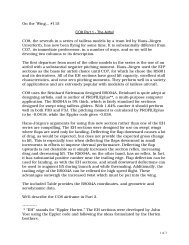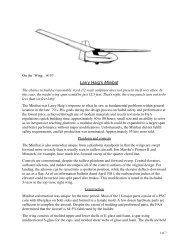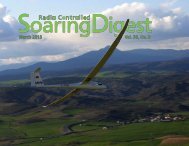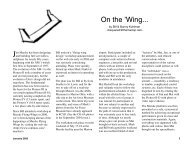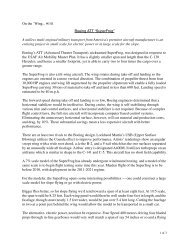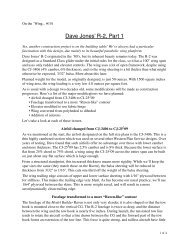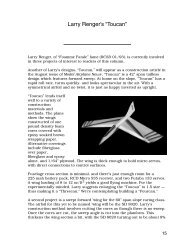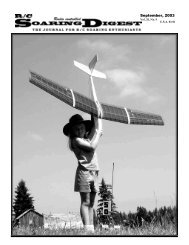160 Plank vs Sweptcomplete.FM5 - Radio Controlled Soaring Digest
160 Plank vs Sweptcomplete.FM5 - Radio Controlled Soaring Digest
160 Plank vs Sweptcomplete.FM5 - Radio Controlled Soaring Digest
Create successful ePaper yourself
Turn your PDF publications into a flip-book with our unique Google optimized e-Paper software.
Aileron function is a bit more problematic for swept wing aircraft than for planks, but thereare also some tantalizing possibilities. Adverse yaw is the major problem involved in use ofailerons. In conventional aircraft, adverse yaw is compensated for by aileron differential — theaileron moves further upward than downward — and judicious use of rudder. This is not possibleon the swept wing because of the aft location of the aileron on the wing. The upward movingaileron, with greater deflection, will always tend to pitch the aircraft upward. There are somerather complicated ways of overcoming this tendency, but these involve either some sort ofauxiliary control surface actuated through a mixing function or a special twist and liftdistributions.For a plank with a high aspect ratio tapered planform and a central elevator acting through alarge local chord, like the PN9f or Pioneer II, the outboard ailerons are so close to the CG that anydifferential has no effect on pitch at all. Some method of inhibiting adverse yaw, such as Frisetypecontrol surfaces, may be necessary on a plank with a lower aspect ratio.A single central vertical fin and rudder can be used quite effectively on a plank planform.Proper contouring of the wing-fuselage junction will normally provide a protrusion behind thewing on which this flying surface can be mounted. If there is no fuselage at all, a lightweightboom can be used. It’s important to get a sufficient arm for the fin and rudder to work through.Sweeping the surface rearward can be used to move the aerodynamic center of the flight surfacefurther aft, but it should be noted that a swept hinge line will affect the aircraft in pitch. Someamount of downward lift will be generated each time the rudder is deflected. A swept backvertical fin alone can be used very effectively on designs which do not require a rudder. Thestatements above hold true for swept wings as well.Flaps are always an interesting proposition on tailless aircraft. Conventional tailed aircraft canreadily handle all sorts of flap deflection. That’s because the elevator is mounted on a generousarm, and as long as it’s out of the wing wake, it has a lot of control over the aircraft pitch angleand hence the wing angle of attack. Tailless aircraft, whether swept wing or plank, have a shorterelevator arm. This limits the amount of control over pitch that the elevator has, but controlproblems usually do not arise because of the inherent low moment of inertia. As flaps aredeflected, however, large moments can be generated which cannot be acceptably controlled. It’simportant to formulate the flap size, shape and placement such that deflection does not produceadverse pitching moments.For a plank, flaps of about five percent of the total wing area can usually be mounted such thattheir hinge is at 40% of the local chord. Such a placement minimizes any pitching tendency as theflaps are deflected. Deflection angles of 45 degrees are sufficient. It should be noted that flaps ofthis type are not to be used to improve thermal performance, as the increased lift is far outweighedby the tremendous amounts of drag produced. Such flaps can, however, be used to increase theheight achieved on a winch launch and to effectively control the glide path during landingapproaches.Flaps on swept wings can be used as a means of glide path control and to improve boththermal and high speed performance. Again, placement is an issue, as pitch control should not beadversely affected. Flaps for swept wings should be placed at the trailing edge, but theirplacement along the span is not easily determined. Too far inward and the wing will tend to pitchupward. Too far outboard and flap deflection will force the nose down. Overall size and localchord have an influence as well. Ideally, inner flaps should be deflected downward some small3 of 8



